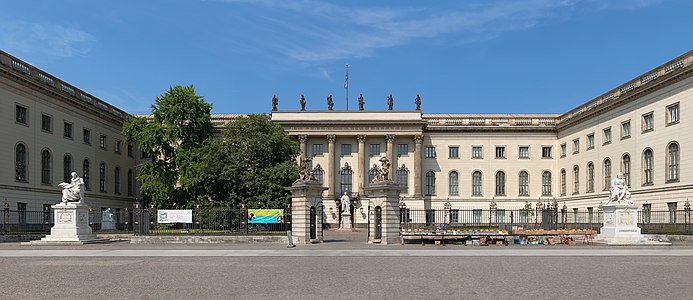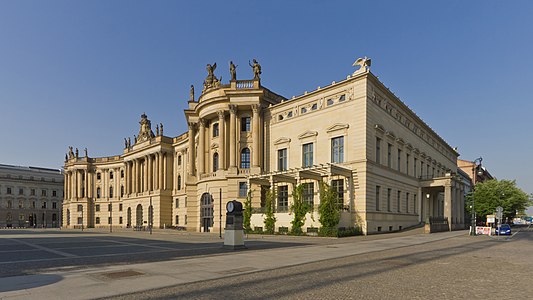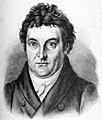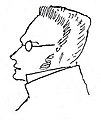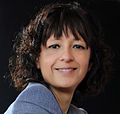Humboldt University of Berlin
Humboldt-Universität zu Berlin | |
| Website | hu-berlin.de |
|---|---|
The Humboldt University of Berlin (German: Humboldt-Universität zu Berlin, abbreviated HU Berlin) is a public research university in the central borough of Mitte in Berlin, Germany.
The university was established by
The university is divided into nine faculties including its medical school shared with the Freie Universität Berlin. The university has a student enrollment of around 32,000 students, and offers degree programs in some 189 disciplines from undergraduate to post-doctorate level.[11] Its main campus is located on the Unter den Linden boulevard in central Berlin. The university is known worldwide for pioneering the Humboldtian model of higher education, which has strongly influenced other European and Western universities.[12]
It was generally regarded as the world's preeminent university for the
History
Main building
The main building of Humboldt-Universität is the Prinz-Heinrich-Palais (English: Prince Henry's Palace) on
In 1967, eight statues from the destroyed Potsdam City Palace were placed on the side wings of the university building. Currently there is discussion about returning the statues to the Potsdam City Palace, which was rebuilt as the Landtag of Brandenburg in 2013.[15]
Early history
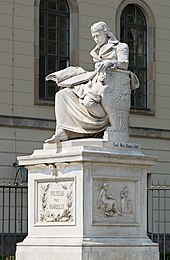
The University of Berlin was established on 16 August 1809, on the initiative of the liberal Prussian educational politician
The university has been home to many of Germany's greatest thinkers of the past two centuries, among them the subjective idealist philosopher
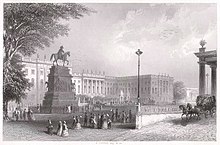
The founders of Marxist theory Karl Marx and Friedrich Engels attended the university, as did poet Heinrich Heine, novelist Alfred Döblin, founder of structuralism Ferdinand de Saussure, German unifier Otto von Bismarck, Communist Party of Germany founder Karl Liebknecht, African American Pan Africanist W. E. B. Du Bois and European unifier Robert Schuman, as well as the influential surgeon Johann Friedrich Dieffenbach in the early half of the 1800s.
The structure of German research-intensive universities served as a model for institutions like Johns Hopkins University. Further, it has been claimed that "the 'Humboldtian' university became a model for the rest of Europe [...] with its central principle being the union of teaching and research in the work of the individual scholar or scientist."[20]
Enlargement

In addition to the strong anchoring of traditional subjects, such as science, law, philosophy, history, theology and medicine, the university developed to encompass numerous new scientific disciplines.
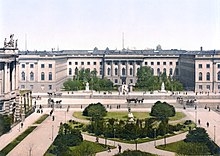
During this period of enlargement, the university gradually expanded to incorporate other previously separate colleges in Berlin. An example would be the Charité, the Pépinière and the Collegium Medico-chirurgicum. In 1710, King Friedrich I had built a quarantine house for Plague at the city gates, which in 1727 was rechristened by the "soldier king" Friedrich Wilhelm: "Es soll das Haus die Charité heißen" (It will be called Charité [French for charity]). By 1829 the site became the Friedrich Wilhelm University's medical campus and remained so until 1927 when the more modern University Hospital was constructed.
The university started a
In August 1870, in a speech delivered on the eve of war with France, Emil du Bois-Reymond proclaimed that "the University of Berlin, quartered opposite the King's palace, is, by the deed of our foundation, the intellectual bodyguard of the House of Hohenzollern (das geistige Leibregiment des Hauses Hohenzollern)."[22]
Third Reich
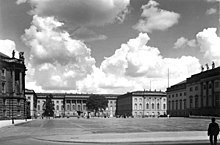
After 1933, like all German universities, Friedrich Wilhelm University was affected by the Nazi regime. The rector during this period was Eugen Fischer. It was from the university's library that some 20,000 books by "degenerates" and opponents of the regime were taken to be burned on 10 May of that year in the Opernplatz (now the Bebelplatz) for a demonstration protected by the SA that also featured a speech by Joseph Goebbels. A monument to this can now be found in the center of the square, consisting of a glass panel opening onto an underground white room with empty shelf space for 20,000 volumes and a plaque, bearing an epigraph from an 1820 work by Heinrich Heine: "Das war ein Vorspiel nur, dort wo man Bücher verbrennt, verbrennt man am Ende auch Menschen" ("This was but a prelude; where they burn books, they ultimately burn people").
The Law for the Restoration of the Professional Civil Service (German "Gesetz zur Wiederherstellung des Berufsbeamtentums") resulted in 250 Jewish professors and employees being fired from Friedrich Wilhelm University during 1933–1934 and numerous doctorates being withdrawn. Students and scholars and political opponents of Nazis were ejected from the university and often deported. During this time nearly one third of all of the staff were fired by the Nazis.
Cold War
This article needs additional citations for verification. (August 2017) |
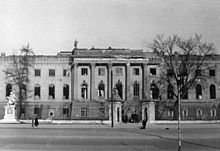

During the
Since the historical name, Friedrich Wilhelm University, had monarchic origins, the school was officially renamed in 1949. Although the Soviet occupational authorities preferred to name the school after a communist leader, university leaders were able to name it the Humboldt-Universität zu Berlin, after the two Humboldt brothers, a name that was also uncontroversial in the west and capitalized on the fame of the Humboldt name, which is associated with the Humboldtian model of higher education.[24]
Modern Germany
After the German reunification, the university was radically restructured under the Structure and Appointment Commissions, which were presided by West German professors.[25][26] For departments on social sciences and humanities, the faculty was subjected to a "liquidation" process, in which contracts of employees were terminated and positions were made open to new academics, mainly West Germans. Older professors were offered early retirement.[26][27] The East German higher education system included a much larger number of permanent assistant professors, lecturers and other middle level academic positions. After reunification, these positions were abolished or converted to temporary posts for consistency with the West German system.[28] As a result, only 10% of the mid-level academics in Humboldt-Universität still had a position in 1998.[26] Through the transformations, the university's research and exchange links with Eastern European institutions were maintained and stabilized.[25]
Today, Humboldt University is a state university with a large number of students (36,986 in 2014, among them more than 4,662 foreign students) after the model of West German universities, and like its counterpart the Freie Universität Berlin.
The university consists of three different campuses, namely Campus Mitte, Campus Nord and Campus Adlershof. Its main building is located in the centre of Berlin at the boulevard
Organization

The aforementioned nine faculties into which the university is divided:[29]
- Faculty of Law
- Faculty of Mathematics and )
- Faculty of Life Sciences (Agriculture and Horticulture, Biology, Psychology)
- Charité – Berlin University of Medicine (jointly with Free University of Berlin)
- Faculty of Philosophy I (Philosophy, History, European Information Science)
- Faculty of Philosophy II (Literature, Classical Philology)
- Faculty of Quality Managementin Education)
- Faculty of Theology
- Faculty of Economics and Business Administration
Furthermore, there are two independent institutes (Zentralinstitute) that are part of the university:
- Centre for British Studies (in German: Großbritannienzentrum)
- Humboldt-Innovation (research transfer and spin-off service)
- Museum für Naturkunde (Natural History Museum)
- Späth-Arboretum
Student representation
Each year, students elect the Studierendenparlament, which serves as the body of student representatives under German law.[30]
| Lists | Votes | % | ± | Seats | ± | |
|---|---|---|---|---|---|---|
| Juso-Hochschulgruppe | 252 | 21.5 | 7.1 | 13 | +4 | |
| OLKS – OffeneListeKritischerStudierender | 180 | 15.4 | 5.8 | 9 | +3 | |
| Linke Liste an der HU – LiLi | 156 | 13.3 | −0.9 | 8 | 0 | |
| Association of Christian Democratic Students (Ring Christlich-Demokratischer Studenten) – Demokratisch. Praktisch. Gut. | 151 | 12.9 | 6.7 | 8 | +4 | |
| Grünboldt | 115 | 9.8 | 3.4 | 6 | +2 | |
| Queer-feministische LGBT*I*Q*-Liste | 114 | 9.7 | 3.8 | 6 | +3 | |
| Die Linke.SDS HU Berlin | 88 | 7.5 | 4.8 | 4 | +2 | |
| IYSSE | 63 | 5.4 | 2.7 | 3 | +1 | |
| João & the autonome alkis.Die LISTE | 53 | 4.5 | 2.1 | 3 | +2 | |
| Total | 1172 | 100% | 60 | |||
Library
When the Royal Library proved insufficient, a new library was founded in 1831, first located in several temporary sites. In 1871–1874 a library building was constructed, following the design of architect Paul Emanuel Spieker. In 1910 the collection was relocated to the building of the Berlin State Library.
During the Weimar Period the library contained 831,934 volumes (1930) and was thus one of the leading university libraries in Germany at that time.
During the Nazi book burnings in 1933, no volumes from the university library were destroyed. The loss through World War II was comparatively small. In 2003, natural science-related books were outhoused to the newly founded library at the Adlershof campus, which is dedicated solely to the natural sciences.
Since the premises of the State Library had to be cleared in 2005, a new library building was erected close to the main building in the center of Berlin. The "Jacob und Wilhelm Grimm-Zentrum" (Jacob and Wilhelm Grimm Centre, Grimm Zentrum, or GZ as referred to by students) opened in 2009.
In total, the university library contains about 6.5 million volumes and 9,000 held magazines and journals, and is one of the biggest university libraries in Germany.
The books of the Institut für Sexualwissenschaft were destroyed during the Nazi book burnings, and the institute destroyed. Under the terms of the Magnus Hirschfeld Foundation, the government had agreed to continue the work of the institute at the university after its founder's death. However, these terms were ignored. In 2001, the university acquired the Archive for Sexology from the Robert Koch Institute, which was founded with a large private library donated by Erwin J. Haeberle. This has now been housed at the new Magnus Hirschfeld Center.[33]
Academics
| University rankings | |||||||
|---|---|---|---|---|---|---|---|
| Overall – Global & National | |||||||
| |||||||
Rankings
According to the 2024 QS World University Rankings, the university ranked 120th globally and 7th at the national level.[34] Additionally, in the Times Higher Education World University Rankings for 2024, it was placed at 87th worldwide and 4th within the country.[35] Because of an unresolved dispute over the counting of Nobel laureates before the Second World War – both Humboldt University and the Free University of Berlin claim to be the rightful successor of the Friedrich Wilhelm University – both do not appear in the Academic Ranking of World Universities (ARWU) anymore since 2008.[36]
In the 2023 QS Subject Ranking, Humboldt University ranks first in Germany in the arts and humanities and the social sciences.[37] In the 2024 THE Subject Ranking, Humboldt University ranks second in Germany in the arts and humanities, law, psychology, and social sciences.[38] In the 2023 ARWU Subject Ranking, Humboldt University ranks first in Germany in geography.[39]
|
| |||||||||||||||||||||||||||||||||||||||||||||||||||||||||||||||||||||||||||||||||||||||||||||||||||||||||||||||||||||||||||||||||||||||||||||||||||||||||||||||||||||||||||||||||||||||||||||||||||||||||||||||||||||||||||||||||||||||||||||||||||||||||||||||
Measured by the number of top managers in the German economy, Humboldt-Universität ranked 53rd in 2019.[40] In 2020, the American U.S. News & World Report listed Humboldt-Universität as the 82nd best in the world, climbing eight positions, being among the 100 best in the world in 17 areas out of 29 ranked.[41]
International partnerships
HU students can study abroad for a semester or a year at partner institutions such as the University of Warwick, Princeton University, and the University of Vienna.
Notable alumni and faculty
-
Albert Einstein, theoretical physicist known for developing the theory of relativity and recipient of the Nobel Prize in Physics
-
Erwin Schrödinger, physicist who developed a number of fundamental results in quantum theory, recipient of the Nobel Prize in Physics
-
Max Planck, theoretical physicist and originator of quantum theory, recipient of the Nobel Prize in Physics
-
Max von Laue, physicist and recipient of the Nobel Prize in Physics
-
Paul Ehrlich, physician known for curing syphilis and recipient of the Nobel Prize in Physiology or Medicine
-
Albrecht Kossel, biochemist who pioneered in the study of genetics and recipient of the Nobel Prize for Physiology or Medicine
-
Jacobus Henricus van 't Hoff, pioneering chemist and the first winner of the Nobel Prize in Chemistry
-
radioactivity and radiochemistry, and recipient of the Nobel Prize for Chemistry
-
Rudolf Virchow, physician anthropologist, pathologist, prehistorian, biologist, father of modern pathology
-
Theodor Mommsen, classical scholar and recipient of the Nobel Prize in Literature
-
Alfred Wegener, polar researcher and geophysicist who originated the continental drift hypothesis
-
Werner Heisenberg, theoretical physicist and pioneer of quantum mechanics
-
Karl Weierstrass, mathematician, considered "the father of modern analysis"
-
Jakob and Wilhelm Grimm, best-known collectors of German and European folk tales
-
Heinrich Heine, poet best known for his early lyric poetry
-
Yeshayahu Leibowitz, public intellectual, scientist, and writer
-
Karl Marx, philosopher, political theorist, and socialist revolutionary
-
Friedrich Engels, philosopher and revolutionary socialist
-
Angela Davis, political activist, philosopher
-
Georg Wilhelm Friedrich Hegel, idealist philosopher and one of the fundamental figures of modern Western philosophy
-
Johann Gottlieb Fichte, philosopher, German idealist
-
Walter Benjamin, philosopher, cultural critic and essayist
-
Ernst Cassirer, idealist philosopher
-
Arthur Schopenhauer, philosopher
-
Leopold von Ranke, historian, founder of modern source-based history
-
Barthold Georg Niebuhr, historian, statesman, banker, father of modern scholarly historiography
-
Felix Mendelssohn, composer during the early Romantic period
-
Georg Simmel, sociologist and philosopher
-
W.E.B. Du Bois, civil rights activist and academic
-
Karl Liebknecht, socialist politician and revolutionary
-
Gustav Stresemann, statesman during the Weimar Republic and recipient of the Nobel Peace Prize
-
Austen Chamberlain, statesman and recipient of the Nobel Peace Prize
-
Left Party (Germany)
-
Dietrich Bonhoeffer, theologian, pastor, anti-Nazi dissident, founder of the Confessing Church
-
Protestant theology"
-
Emmanuelle Charpentier, professor and recipient of the Nobel Prize in Chemistry
- Monika Lüke, international law scholar and former secretary general Amnesty International, Germany
See also
References
- ^ a b c Langner, Stefanie. "Man beruft eben tüchtige Männer und läßt die Universität sich allmählich encadrieren — Humboldt-Universität zu Berlin". www.hu-berlin.de.[permanent dead link]
- ^ "Leistungsbericht über das Jahr 2022" (PDF) (in German). Senate Chancellery of Berlin. p. 1. Retrieved 8 April 2024.
- ^ a b c "Facts and Figures". Humboldt University of Berlin. Archived from the original on 16 July 2020. Retrieved 15 June 2017.
- ^ a b c "Humboldt-Universität zu Berlin". Archived from the original on 3 December 2013. Retrieved 2 December 2013.
- ^ a b List of Nobel laureates by university affiliation
- ^ design. "Hausfarben der Humboldt-Universität". Humboldt-Universität zu Berlin (in German). Archived from the original on 7 October 2022. Retrieved 7 October 2022.
- ^ "Das moderne Original der Reformuniversität" (in German). Humboldt-Universität zu Berlin. Archived from the original on 4 July 2022. Retrieved 15 January 2018.
- ^ "Humboldt University of Berlin – university, Berlin, Germany". Encyclopedia Britannica. Archived from the original on 11 May 2018. Retrieved 11 May 2018.
- Frederick II, had built for him between 1748 and 1753 on the avenue Unter den Linden.
- ^ a b "Berlin's oldest university faces new challenges as it turns 200". Deutsche Welle. 15 October 2010. Archived from the original on 4 June 2019. Retrieved 4 June 2019.
- ^ hu_adm. "Daten und Zahlen zur Humboldt-Universität — Humboldt-Universität zu Berlin". www.hu-berlin.de (in German). Archived from the original on 23 November 2016. Retrieved 11 January 2018.
- ISBN 9789264017450
- ISBN 9780393070422
- ^ Humboldt-Universität Archived 1 August 2020 at the Wayback Machine (in German) Landesdenkmalamt Berlin
- ^ "Die Attikaskulpturen". Humboldt-Universität zu Berlin (in German). 2017. Archived from the original on 5 February 2023. Retrieved 11 February 2023.
- ^ temp_adm. "Short History — Humboldt-Universität zu Berlin". www.hu-berlin.de. Archived from the original on 10 October 2022. Retrieved 11 May 2018.
- ^ a b Nolte, Dorothee (12 October 2009). "200 Jahre Humboldt-Uni: Der Ort: Ein Palais Unter den Linden". Die Zeit. Archived from the original on 11 May 2018. Retrieved 11 May 2018.
- ISBN 0-86091-329-5.
- ^ Mclellan, David (1981). Karl Marx: A Biography (Fourth ed.). Palgrave Macmillan. p. 15.
- ^ Anderson, Robert (March 2010). "The 'Idea of a University' today". History & Policy. United Kingdom. Archived from the original on 31 March 2014. Retrieved 9 December 2010.
- ^ Rüegg 2004, pp. 4–6
- ^ Hayek, Friedrich A. (13 September 2010). "Planning, Science, and Freedom". Mises Institute. Archived from the original on 25 February 2021. Retrieved 1 June 2021.
- ^ from the original on 12 June 2020. Retrieved 13 April 2020.
- ^ "Die Umbenennung zur "Humboldt-Universität" — Presseportal". Hu-berlin.de (in German). Archived from the original on 20 February 2015. Retrieved 28 August 2016.
- ^ a b "Short History". Humboldt-Universität zu Berlin. Archived from the original on 10 October 2022. Retrieved 2 June 2020.
- ^ ISBN 9781785339264. Archivedfrom the original on 24 October 2023. Retrieved 2 June 2020.
- ISBN 9781438465388. Archivedfrom the original on 24 October 2023. Retrieved 2 June 2020.
- ISBN 9780415306591.
- ^ "Faculties and Departments". Humboldt-Universität zu Berlin. Archived from the original on 9 October 2016. Retrieved 22 August 2015.
- ^ mig_adm. "StuPa". Gremien und Beauftragte der HU (in German). Archived from the original on 17 October 2022. Retrieved 17 October 2022.
- ^ Studentischer Wahlvorstand (13 July 2022). "Vorläufiges amtliches Endergebnis der Wahl der Mitglieder des 30. Studierendenparlaments" (PDF). HU Berlin. Archived (PDF) from the original on 17 October 2022. Retrieved 17 October 2022.
- ^ Studentischer Wahlvorstand (14 August 2021). "Vorläufiges amtliches Endergebnis der Wahl der Mitglieder des 29. Studierendenparlaments" (PDF). HU Berlin. Archived (PDF) from the original on 4 January 2023. Retrieved 17 October 2022.
- ^ Erwin J Haeberle". "Berlin and its Sexological Heritage". Magnus Hirschfeld Archive for Sexology. Archived from the original on 30 August 2009.
- ^ a b "QS World University Rankings 2024". QS World University Rankings. Archived from the original on 17 September 2012. Retrieved 16 July 2023.
- ^ a b "World University Rankings 2024". Times Higher Education World University Rankings. 27 September 2023. Archived from the original on 28 September 2023. Retrieved 27 September 2023.
- CiteSeerX 10.1.1.126.3066.
- ^ a b "QS World University Rankings by Subject 2022". QS World University Rankings. 23 March 2023. Archived from the original on 26 October 2022. Retrieved 2 August 2023.
- ^ a b "World University Rankings by subject". Times Higher Education World University Rankings. Retrieved 10 October 2023.
- ^ a b "ShanghaiRanking's Global Ranking of Academic Subjects 2023". Academic Ranking of World Universities. Retrieved 10 October 2023.
- ^ "An diesen Unis haben die DAX-Vorstände studiert | charly.education". www.charly.education (in German). Archived from the original on 2 August 2019. Retrieved 19 October 2019.
- ^ "Humboldt University of Berlin". usnews.com/. Archived from the original on 27 October 2020. Retrieved 21 October 2020.
Further reading
- Ash, Mitchell G. (2006). "Bachelor of What, Master of Whom? The Humboldt Myth and Historical Transformations of Higher Education in German-Speaking Europe and the US1". European Journal of Education. 41 (2). Wiley: 245–267. ISSN 0141-8211.
- McClelland, Charles E. (2016). Berlin, the Mother of All Research Universities: 1860–1918. Lanham: Lexington Books. OCLC 958371470.
- McClelland, Charles E. (1980). State, society, and university in Germany 1700-1914. Cambridge: Cambridge University Press. OCLC 708362287.
External links
- Official website (in German and English)

